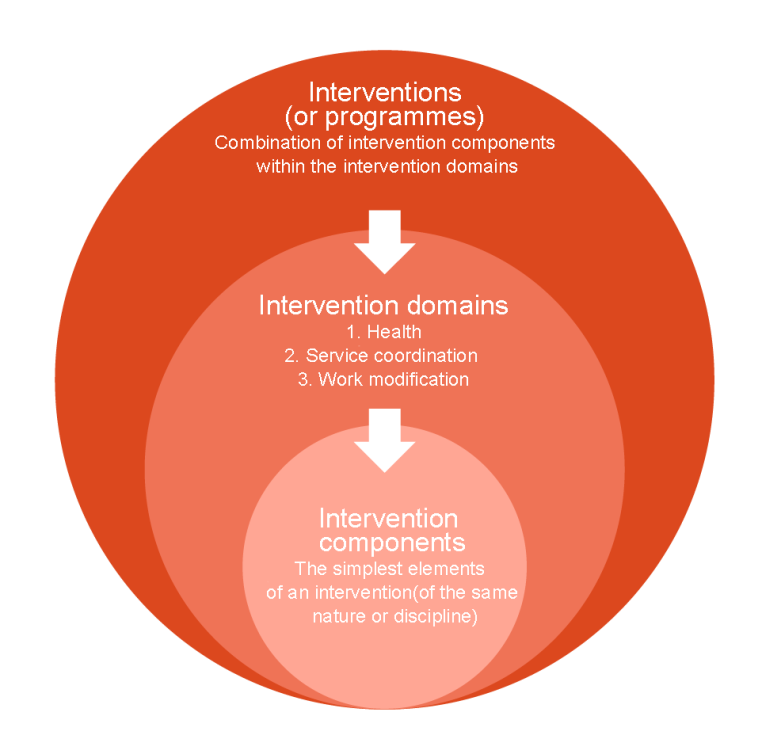Caveats and limitations
Caveats – Factors that positively/negatively influence duration of absence or RTW
The information provided here should be seen primarily as a guide to inform RTW stakeholders about the elements that can impede RTW as well as the elements that can promote RTW. It is a companion tool to facilitate communication with workers and other RTW stakeholders.
Adding up the factors to establish a severity score for the worker’s disability
situation should be avoided for the following reasons: the weight or influence of the different factors is not known, nor is the interaction between these different factors. In addition, some factors that positively influence the results may counterbalance the impact of some factors that negatively influence these results.
The presence of organizational factors negatively influencing RTW should ideally be accompanied by an in-depth assessment of the work context and a workplace visit, both carried out by a qualified practitioner (e.g., ergonomist, occupational therapist, rehabilitation counsellor). As an intervener, it is important to use your judgment of the overall picture of the worker and, above all, to contextualize this picture in terms of the worker’s universe and the organization. Assessment and intervention
is an art in itself.
Being aware of personal factors certainly provides a more complete picture of the worker’s situation, but must be treated with vigilance, since the spheres of work and personal life are not always watertight.
Cautions – Measuring Tools
Factors that positively/negatively influence the duration of absence or RTW can only be assessed by accredited professionals, which implies costs for the organization, if any. This information is provided in the description of the tools that allow for their measurement.
It is important to remember that self-administration or administration of a questionnaire by an unqualified person can lead to undesirable consequences such as the calculation of erroneous scores and the misinterpretation of results that may result.
When using a measurement tool with an employee or a client, we would like to specify that the philosophy of this platform’s team is, above all, to investigate certain factors in greater detail, depending on the type of absence of the worker (MSD, CMD). However, in the end, the results of these measurement tools will be used to better understand the worker and to establish a dialogue with the latter, rather than to establish thresholds that would allow the practitioner to categorize the person being evaluated. The team therefore advocates a philosophy of dialogue with the worker concerned in order to better accompany or counsel him or her.
Limitations – Factors that positively/negatively influence RTW or duration of absence
Only personal, organizational and health-related factors that predict the duration of absence or RTW are considered. Factors related to other outcome
measures, such as productivity
, presenteeism
or work status (partial return, full return, job retention) are therefore not identified. This is also the case for factors predictive of symptoms or illnesses, which may explain why several factors that may be thought to be involved are not included here, but rather in studies or reviews on primary prevention
.
The available sources also did not allow for the identification of environmental factors outside the workplace, such as factors at the societal level or at the level of the health care system, the insurance system and the community. Studies on these other factors are much less numerous, which explains this choice. The ecological model of work disability
provides a good understanding of the universe in which factors can be identified.
Limitations – Measurement Tools
The same factor
is often defined/operationalized differently by different authors. In addition, each tool captures only part of the “complete” definition of each factor
. As a result, the use of more than one tool is sometimes necessary to get close to a complete assessment of a factor
(e.g., using two questionnaires to measure perceived barriers during RTW). Finally, it should be noted that the qualities of the same tool may vary according to the language and the target population.
The assessment of each of the factors involves different types of tools that have several psychometric properties. These psychometric qualities or properties allow us to make recommendations about whether or not to use the tool. This is often a difficult exercise, as each tool has strengths and limitations. Whenever possible, we recommend one or more tools to assess a factor
, based on scientific criteria and applicability in the user context. This trade-off is not always easy to determine and it is therefore strongly suggested that the arguments or criteria that have been discussed be considered before using the tool.
The measurement tools are intended for interveners, as the research was primarily concerned with their role. It was possible to determine this from the literature review.
